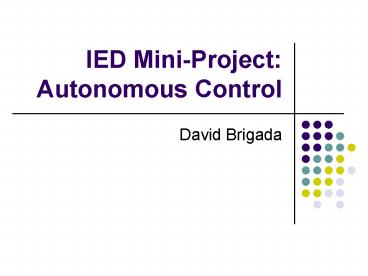IED MiniProject: Autonomous Control - PowerPoint PPT Presentation
1 / 15
Title:
IED MiniProject: Autonomous Control
Description:
Radio interference. Approaches to. Autonomous Control. Vision. Interactive & dynamic response ... Add manual override radio control. Implementation for. Mini-Project ... – PowerPoint PPT presentation
Number of Views:118
Avg rating:3.0/5.0
Title: IED MiniProject: Autonomous Control
1
IED Mini-ProjectAutonomous Control
- David Brigada
2
Overview
- Types of control considered
- Approaches to autonomous control
- Overview of selected system
- Implementation for mini-project
- Testing results
- Demonstration
3
Types of Control Considered
- Tethered remote control
- Human interactivity
- Tether issues
- Radio control
- Human interactivity
- More complex
- Radio interference
4
Approaches toAutonomous Control
- Vision
- Interactive dynamic response
- Computationally intensive
- Difficult to get right
- Sound
- Interactive dynamic response
- Small amounts of data
- Easily get lost
5
More Approaches toAutonomous Control
- GPS
- Non-interactive
- Provides position information
- Not reliable inside buildings
- Limited precision
6
Overview of Selected System
- Sound Trilateration
- Similar to GPS
- Beacons deployed around corners of maze
- Software decodes position from relative signal
timings
7
Sound Trilateration
8
Use of Position Information
- Algorithm uses timings to find
- Position
- Bearing
- Speed
- Algorithm is programmed with a set of points
- Waypoints lead a path through maze
- Algorithm follows waypoints one after another
- Actions can be programmed at waypoints
- Collect or deposit balls
9
Limitations of Selected System
- No response to dynamic environment
- Handling balls that have moved
- Interacting with other robot
- Not a common solution to this problem
- Possible approaches
- Add sensors to detect environment change
- Add manual override radio control
10
Implementation forMini-Project
- Interface access limitations time constraint
- Difficulty of testing
- Solution
- Simulate the control algorithm and environment
- Client/server model
- Server Simulates physics of maze environment
- Also displays results for interpretation
- Client Runs control algorithm
11
Client program
- Design like intended target system
- Contains all the functionality of the control
algorithm - Takes differential time inputs
- Produces steering and drive outputs
12
Server program
- Simulates the environment
- Calculates timing differences for dispatch to
control algorithm - Calculates kinematics of robot motion
- Displays output
- 3 dimensional output rendered in OpenGL
13
Client and ServerCommunications
- Client sends drive motor duty cycle and servo
motor pulsewidth - Server sends beacon timing differences
- Server does NOT send position, bearing, or speed
directly to client
Signal timings
Server
Client
Output waveforms
14
Testing Results
- Tests were done to ensure accuracy of robot
response - Control algorithm was continually able to
reproduce its movements within very small
fractions of an inch - Control algorithm maintained integrity to ½ inch
until system precision was reduced to one
twentieth of nominal value - Unknown noise levels from inputs
15
Demonstration
- The following is a presentation of the simulation
in action. - The system picks random points to visit for this
simulation.































